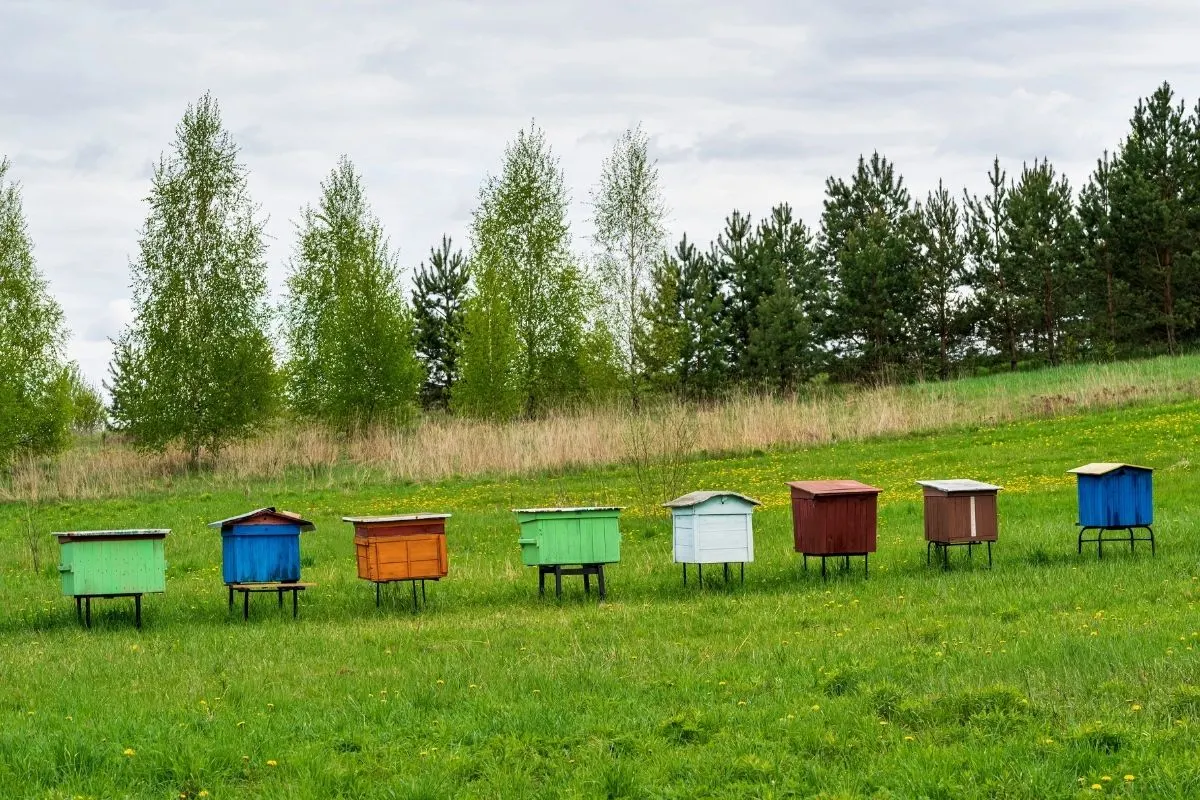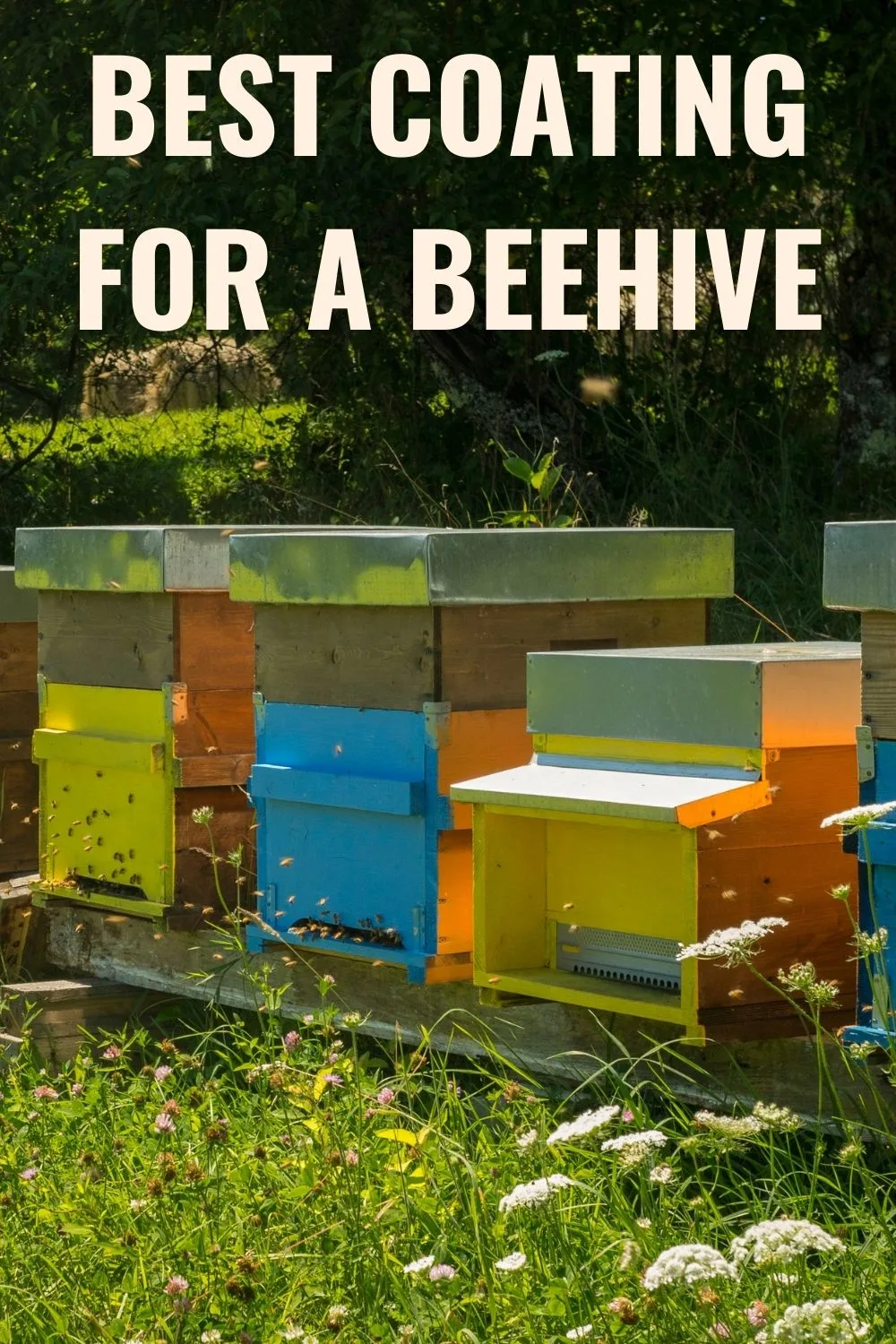What is the best coating for a beehive? When you view photos of beehives, you will see hives coated in various finishes. Some look like natural wood, while others seem to be painted. Most beehives are made from wood, and since beehives are outside and exposed to the elements, they need some protection to ensure longevity. What is the best coating to use on the beehive to protect the hive but be safe for the bees?
The best coating for a beehive is any exterior rated coating with a low VOC to minimize the outgassing of toxins that can be harmful to the bees. Water-based products have a lower VOC than products based on petrochemicals. Stains and varnishes with low VOC can also be used for a natural look.

The variety of finishes on beehives really comes down to the preference of the beekeeper and what is best for the bees. Making the right choice of coating can contribute to the success of your beekeeping adventure, but making the wrong choice can cause your bees to struggle and never be truly productive.
Should You Treat Your Beehive?
Some beekeepers genuinely want to go the organic route and refuse to paint their beehives or put a coating of any kind on the hives.
While this dedication to the natural approach is admirable, it is impractical from the financial aspect of beekeeping.
An unprotected beehive may give you one or two seasons of exposure to the weather. In contrast, a coated hive can last 20-years or more if regular maintenance is done. With the cost to replace a beehive ranging between $100 to $150, it can become an expensive hobby if you need to replace your hives every season.
With the increased focus on health and safety worldwide, many coating manufacturers are producing coatings that have reduced toxin levels, making them better for humans and the environment.
Consequently, you should coat your beehives to maximize the use you get out of the hive, but the choice of coating is an essential consideration for your bees. Not only do you want to choose a coating that will be bee-safe, but you don’t want to contaminate any of the honey in the hive that you will be consuming!
What Is The Best Coating For A Beehive?
The best coating for beehives is one that will introduce a minimal amount of toxins that could pose a danger to the bees or contaminate the honey in the hive.
Most coatings for beehives, such as paints and varnishes, will have a VOC rating on the can. VOC is a metric on coating products such as paint is an acronym for Volatile Organic Compounds and indicates the level of outgassing of toxic chemicals produced by the product.
The VOCs in the coating are released as the product dries, and as a result, the off-gassing rate will diminish over time. Some commercial beekeepers will use products that contain VOCs but will prepare their hives well in advance, giving the hives time to air before housing bees in the hive.
Many modern paints will be labeled as Low VOC or VOC-free, or “natural,” which indicates a lower content of toxins in the product that will release over time. VOC-free products are not completely free of VOCs but generally have levels of less than 5g/L. Low VOC products will have a VOC level of below 50g/L.
For general beekeepers who do not have the luxury of time, the choice of coating for a beehive becomes evident from our discussion thus far.
The best coating choice for a beehive should be a product labeled for exterior use and should have a low VOC or be VOC-free. Products with a VOC level of 50g/L or less can be used, but products with 5g/L or less should be your prime choice.
Water-based products generally have a lower VOC level than products that include petrochemicals. Even though you select a product with a low VOC level, be wary of adding tints and colorants, which could increase the VOC value.
You should always allow your newly coated hive to air and breathe before housing any bees. The minimum recommended time to wait before putting bees in a freshly coated hive is 1 week, but a longer time is generally safer. I prefer to do all my hive maintenance and painting new hives in the wintertime, which gives them a good time to air out before housing bees in the spring.
What Surfaces Of A Beehive Should You Paint?
When contemplating painting your beehives to protect them from the damaging outdoor environment, there are a few simple guidelines that you should adhere to.
The only beehive areas that should be coated are the exterior parts exposed to the elements. The hive’s interior should be left untouched in its natural wood state to avoid causing the bees any health problems and risk contaminating the honey. The frames in the hive should also be left uncoated.
Beeswax as a coating is used by some beekeepers on their hives for environmental protection. If you are using beeswax, you can safely coat both the hive’s interior and exterior for maximum protection.
If you have coated the exterior of your hive with paint or varnish, you could coat the hive’s interior with beeswax, which will also make the hive more attractive to bees.
Beeswax is generally used as a hive coating by beekeepers who have been in the business for some time and have extra beeswax to spare to coat their hives. This solution is generally impractical for new beekeepers just starting out who have no additional wax to spare.
Does Color Matter When Painting A Beehive?

Many beekeepers like to paint their hives in various colors rather than sticking to the traditional white color. The motives behind the colors can vary.
- Aesthetics. Some beekeepers like their apiary site to look bright and colorful!
- Organization. Painting beehives in different colors allows the beekeeper to keep organized, keep certain color hives for certain locations, and match honey supers with brood chambers.
- Temperature regulation. It is common for beekeepers in warmer regions to paint their hives in light colors to reduce the hive absorbing the sun’s heat.
The bees do not really care what color you paint your hives, and there is no evidence that bees will prefer one color over another.
The main rule to remember when painting your hives is temperature regulation. Avoid dark colors that will absorb heat and increase the hive’s internal temperature.
Can You Varnish Your Beehive
You can varnish your hives if you prefer the wood-look to your hives. You can also apply a water-based wood stain to improve the look of the wood before you apply the varnish finish.
The same rules used to choose paint as a hive coating must apply to your choice of stain and varnish. Any varnish with high solvent contents should be avoided to ensure the low VOC of the product.
Water-based stains and finishes will always have lower toxicity than solvent-based products. Using water-based products is not only better for the bees, but the clean-up of your paintbrushes after the application is also easier.
Conclusion
Coating your beehives is a personal choice, but you will find that doing it will make the hives last significantly longer than uncoated ones.
The main concept to remember when selecting a coating for your hives is to use a product rated for exterior use, one with a low VOC, and give your hives time to air out before homing bees in them.
The most important rule is to leave the interior of the hive untouched and uncoated. The raw wood on the inside is healthier for the bees than a coating.
Stick to these basic beehive coating rules, and you will have happy, healthy, and productive bees!


